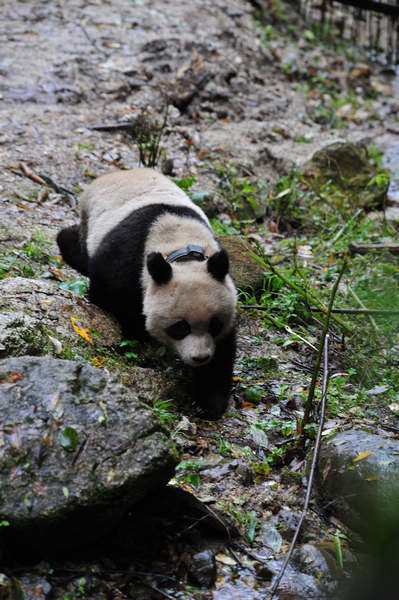Young panda gets a taste of the wild life
 |
|
Artificially bred panda Taotao walks out of its cage to the wild forest at the Lipingzi Nature Reserve in Sichuan province, Oct 11, 2012. [Photo/for China Daily] |
Handlers have had to revise training methods based on lessons learned from the fate of Xiang Xiang, a male panda that died in 2007 after being released into the wild.
"Researchers at Wolong have devised a method of allowing mother pandas to take a leading role in training their cubs, which has greatly improved the field training," Zhang said.
Workers at the reserve rescued Cao Cao, now 15, from the wild when she was young. Although she has since lived in captivity, the fact she was raised by her mother in the wild has made her competent to teach Tao Tao how to climb trees when other animals approach and find food under a blanket of snow.
To help cubs identify what will be natural enemies, handlers made a model leopard, complete with a roaring growl. When Tao Tao passed the model during a test in June, he immediately ran for cover.
Six pandas, along with their mothers, are currently receiving field training at Wolong.
"It's hoped two or three each year will be released into the wild," Zhang said.
Mu Shijie, one of Tao Tao's handlers, said: "I don't worry about him not finding food or evading natural enemies. I only worry about him falling ill out there."
A team of experts will be able to track Tao Tao's activities through a GPS tag attached to his collar.
Xiang Xiang was the first panda in Wolong's survival training program, launched in July 2003. At the time he was almost 2 and was considered the strongest candidate as he had never fallen ill in captivity.
Phase one was conducted in an area of 27,000 sq m, 2,080 meters above sea level. During this phase he learned how to find and select the most nutritious bamboo. During the so-called parasite season, he climbed tall trees and stayed in relatively dry places.
Fourteen months later, Xiang Xiang was moved to an area of 240,000 sq m and 2,480 meters above sea level. Workers showed him videos of lions and leopards so he would recognize natural enemies. He was also shown footage of pandas of various sizes and ages to help him better understand his position in the hierarchy.




















